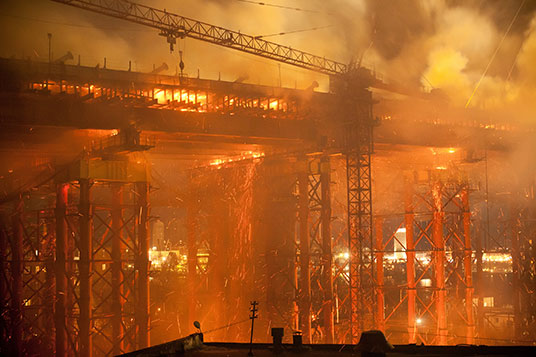Every year, there are many fires on construction sites and in buildings undergoing refurbishment. Often workers are injured, and property is destroyed, causing unexpected costs which businesses many never recover from.
It is important that protective fire measures are put in place to protect a construction site. Bull Products shares its guide on how to prevent a fire from spreading.
Implement the right products
Implementing the correct fire safety products is crucial to prevent a fire from spreading and fire extinguishers are one of the most life-saving products that you can have on site. Fire extinguishers should be located at identified fire points around the site and should be appropriate to the nature of the potential fire:
• Wood, paper and cloth – water extinguisher;
• Flammable liquids – dry powder or foam extinguisher;
• Electrical – carbon dioxide (C02) extinguisher.
Consider how to detect fires
On a smaller site, a standalone alarm unit may be sufficient but as a construction site grows, there is a higher risk of a fire breaking out. By installing fire detection and wireless alarm systems, you can ensure workers are alerted in the event of a fire.
Our Cygnus mobile detection device is an ideal solution for instant fire detection warning and can be used in conjunction with the Fire First Responder Station which connects the detector (smoke or heat) to the alarm on the station. It is suitable for temporary hot works, as it can be moved to where the hazard is and then left there for a period of time to ensure a fire doesn’t start.
Carry out thorough staff training
It is so important to ensure staff are confident when using any type of fire safety equipment – they need to know what risks to be aware of and what actions to take in the event of a fire. All new employees should also receive fire safety training.
Review and update your risk assessment
According to The Regulatory Reform (Fire Safety) Order 2005 (FSO), a ‘responsible person’ must carry out, and keep up to date, a risk assessment and implement appropriate measures to minimise the risk to life and property from fire.
The HSE recommends following these five steps when carrying out a fire risk assessment:
1. Identify hazards: consider how a fire could start and what could burn
2. Identify those at risk: employees, contractors, visitors and anyone who is vulnerable
3. Evaluation and action: consider the hazards and people identified in 1 and 2 and act to remove and reduce risk to protect people and premises
4. Record, plan and train: keep a record of the risks and action taken. Make a clear plan for fire safety and ensure that people understand what they need to do in the event of a fire
5. Review: your assessment regularly and check it takes account of any changes on site.
By following these four steps, you can prevent a fire from spreading, thus protecting your workers and site in the long-term. To find out more about Bull’s products and services, contact Bull on 01432 371170 or visit www.bullproducts.co.uk


